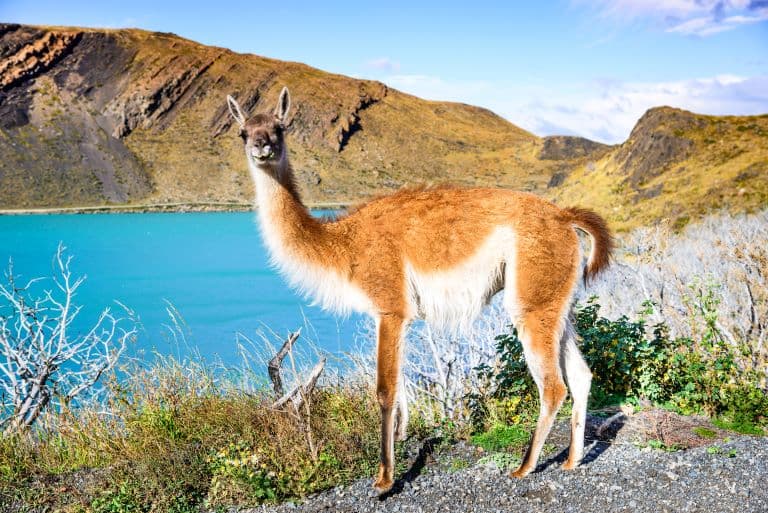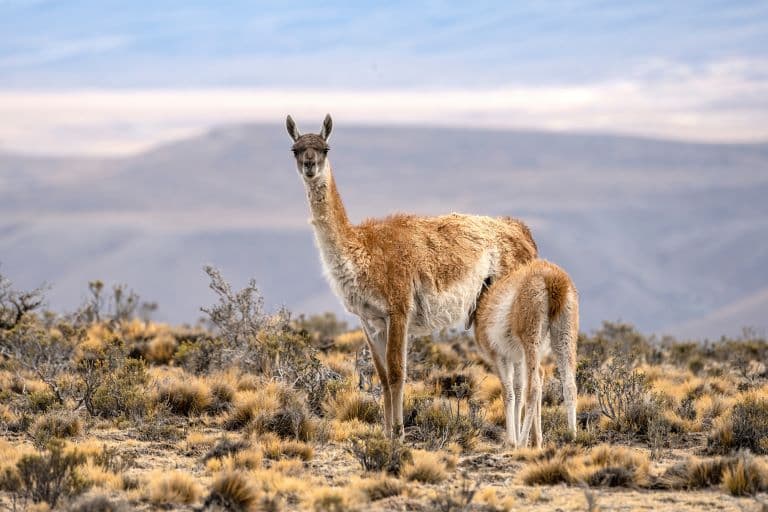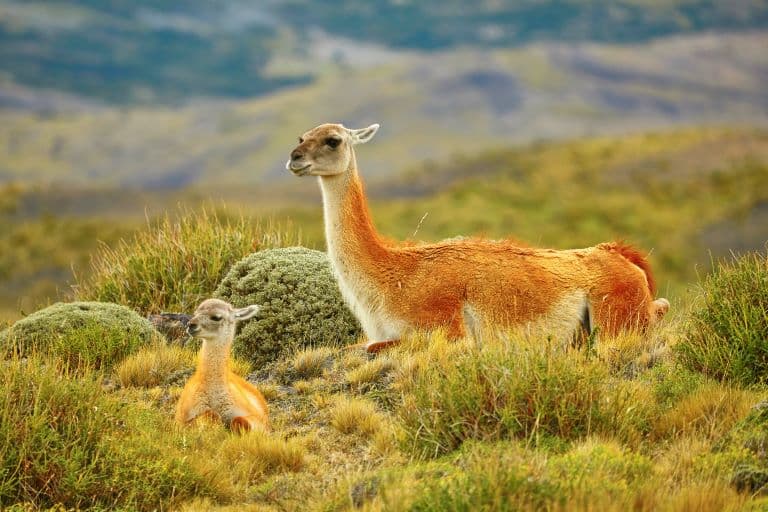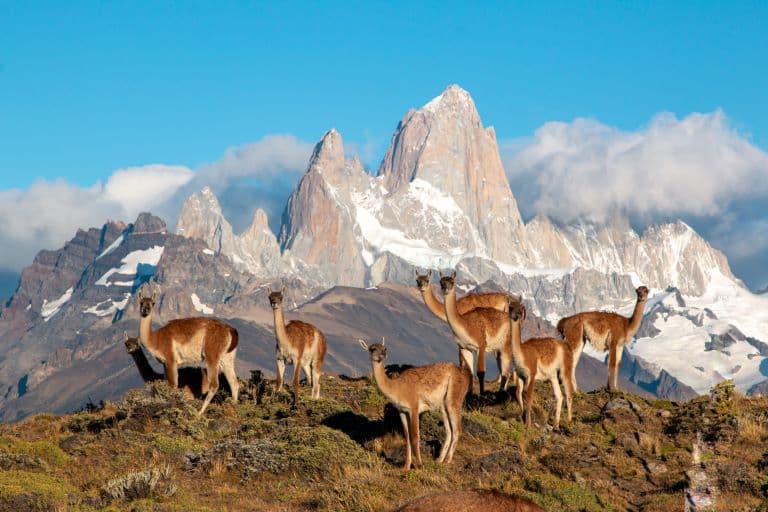Guanaco Profile
The guanaco is a member of the camel family and is found in South America, being one of the largest mammals found on this continent. They have a similar appearance to the domesticated llama but are larger, with males being slightly bigger than females. 1
Their range in South America is fairly extensive and their actual size is variable within this. Their coat colour also differs depending on where they live, varying from light brown, to yellowish brown, to brownish red.
Their diet varies depending on the season, mainly preferring less woody plants when they can get them and utilising shrubs and trees when they have to in the winter months. At times, guanacos have been seen to consume mosses and lichens and even cacti.
They are similar to other members of the camelid family, in the fact that their digestive system is adapted to be able to take in foodstuffs of low nutritional quality. 2

Guanaco Facts Overview
| Habitat: | Grass and scrub land |
| Location: | South America in parts of Argentina, Bolivia, Chile, Paraguay and Peru |
| Lifespan: | 28 years (in the wild) |
| Size: | Length – 155-200cm plus tail Height – 110 – 116cm to the shoulder |
| Weight: | 90-140kg |
| Color: | Pale brown thick, wooly fur on the back with white on the underside. Parts of the head and neck are grey. They are slight in stature, with a large head, long eyelashes and a long neck. They have fairly big ears that point upwards. |
| Diet: | They are herbivorous and eat a diverse range of food sources depending on where they are found; mostly shrubs and grasses. If these are unavailable they will eat fungi, mosses lichen, flowers and fruit. |
| Predators: | Pumas, culepos (on juvenilles) |
| Top Speed: | 64 kmph |
| No. of Species: | 1 (with possibly 2-4 subspecies) |
| Conservation Status: | Least concern |
Guanaco herds are very active throughout the daytime hours, spending most of their time foraging but also resting, keeping vigilant for predators and having bouts of aggression if required. If food is in good supply, herds do not move around a lot and are large in number. In winter when food is less easily found, herds will be smaller with more roaming occurring.
Guanacos are mainly found in groups consisting of females and their young with a single dominant male. Immature males sometimes form small groups after reaching maturity and leaving the family herd, but also solitary males can be found.
Females sometimes move between male territories, especially during the mating season and in general there is a lot of fluidity in the composition of the herd depending on the season.
Females can show aggression when warding off predators such as pumas and culepos and males will show dominant behaviours towards females such as chasing them and biting their legs to try and control the harem. Males will also have brutal fights, bashing and biting one another to try and dominate the group and mate with females by chasing other males away.
The female’s reproductive cycles coincide with the best environmental conditions in terms of food. This tends to be during the rainy seasons.
Once mated a female will ovulate and give birth around 11.5months later. All females in a group will give birth at around the same time as predators will only take a limited number of young and the survivors will keep the numbers in the group strong. Mothers will generally only give birth to one offspring.
Interesting Guanaco Facts
1. Guanaco wool is soft and warm
Guanaco fur started to be used in the textile industry in the 1900’s and is still used today. It is fairly rare and considered very soft and fine. Although guanacos are not bred for their wool, in some areas, wild individuals are captured and sheared and then released back into the herd.

2. Some people believe they are a pest
When guanacos are grazing they can do so where domesticated animals such as cattle, goat and sheep will also graze. Farmers of these animals can sometimes feel that guanaco herds are a pest!
3. They can vary in size, depending on where they are found in their range
As well as their coat colour differing depending on where they are found in South America, their overall size can vary too. The largest guanacos tend to be found in Southern Patagonia and the smallest in Peru. 3
4. Guanacos are very agile on tricky terrain
They have soft, hairless footpads that allow for good contact with the ground, especially when the surface is irregular on rocks, gravel and the like.

5. Guanacos can swim
Guanacos are agile walkers and runners but they are strong swimmers too.
6. Their blood is adapted to be able to cope with high altitudes
As a large proportion of the guanaco population live at high altitudes, where oxygen levels are low, they have a high hemoglobin concentration, about 4 x per unit volume of blood than a humans. This allows more oxygen to be transported around their body. They also have a larger heart than mammals of a similar size to help oxygen transportation too.
7. Their upper lip is split
The upper lip on the guanaco is split into two. This helps it to be more dexterous when extracting leaves from shrubs and bushes, much like fingers.
8. Some guanacos live in deserts and some live in places with high yearly rainfall
Guanacos are very adaptable in terms of the terrain in which they can occupy. Some have a range in the Atacama in Northern Chile which is arid and dry, while others reside in Tierra del Fuego, a very lush and green archipelago at the Southern tip of South America.

9. The ears and tail are used a lot to communicate
If the ears are flat and the tail is up this is a sign of aggression in the guanaco. If the ears are pointing forward this is a sign of alarm. When the guanaco is at ease the ears are usually pointing upwards and the tail is facing down.
Vocalisations are also used to communicate, with a high warble giving a danger warning (some people say this sounds like a laughing noise) and snuffles and screeching showing different levels of aggression.
10. They also communicate through spitting and by depositing dung
Guanacos will spit at one another, even at distances over a metre. This is usually a threatening behavior. Males will also defecate it certain areas to define their territory and make it obvious to other males.
11. Young can stand pretty quickly after birth
Because young guanacos are very vulnerable to predators, they need to be able to stand quickly. They can usually do this in the space of an hour and a half after birth. 4 5
Guanaco Fact-File Summary
Scientific Classification
| Kingdom: | Animalia |
| Phylum: | Chordata |
| Class: | Mammalia |
| Order: | Artiodactyla |
| Family: | Camelidae |
| Genus: | Lama |
| Species Name: | Guanicoe |
Fact Sources & References
- “Guanaco”, National Geographic Kids.
- BBC Earth (2018), “Brutal Fight for Dominance Among Guanacos”, Youtube.
- “Guanaco”, Knitting the Natural Way.
- Horst Erich König (2015), “Macroscopic and histological investigation of guanaco footpads”, NIH.
- “Guanaco”, Idaho Falls.
